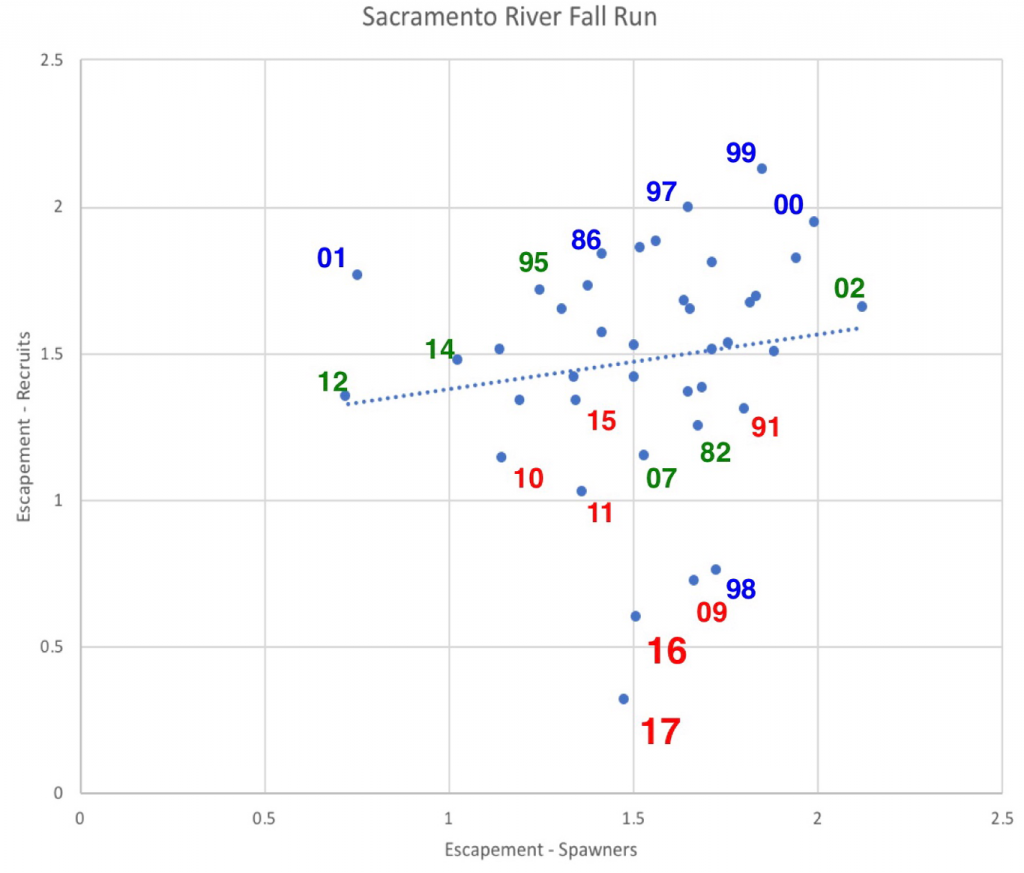In an April 2018 post, I revisited the 2007-2009 salmon crash and warned of the current 2016-2017 crash. In an April 2017 post, I opined on the status of population and its future given the population crashes. In this post, I update the population data with preliminary estimates of the 2016 and 2017 runs, including (1) the in-river estimate from the spawning grounds between Keswick Dam and Red Bluff (Figure 1), and (2) Coleman National Fish Hatchery (CNFH) and Battle Creek (Figure 2).
I developed a stock-recruitment relationship using the in-river data shown in Figure 1. A plot of the population-produced from spawners three years earlier (Figure 3) shows extremely poor runs for 2016 and 2017, given the number of parental spawners three years earlier. The red numbers reflect drought conditions winter-spring of 2014 and 2015, when these broods were rearing and migrating in the Sacramento River in the first few months of their lives. The earlier posts covered the factors that led to poor survival in the drought years.
Forecasts for the 2018 run are mixed. Higher jack numbers in the 2017 run likely foreshadow improvements in the adult 2018 run. Based on the Figure 3 relationships, the higher 2015 run, along with normal year conditions (a green number) for winter-spring 2016 compared to 2014 and 2015, would also indicate an improved run for 2018. A forecast for 2019 and 2020 runs, given the poor runs in 2016 and 2017, is risky at best, despite reasonably good winter-spring conditions in 2017 and 2018 compared to drought years 2014 and 2015. A lack of recovery to 2015 spawner levels in the fall 2018 run would be a serious concern.

Figure 1. Run size estimates (escapement) of fall-run Chinook salmon from spawning grounds in the upper Sacramento River between Keswick Dam and Red Bluff from 1975 to 2017.

Figure 2. Run size estimates (escapement) of fall-run Chinook salmon from the Coleman National Fish Hatchery on Battle Creek near Red Bluff from 1975 to 2017.

Figure 3. Spawner-recruit relationship for fall-run in-river estimates of run size from Figures 1 and 2. Number indicates spawner estimate for that year (y-axis) as derived from spawners three years earlier (x-axis). Color indicates winter-spring rearing-migration conditions for that brood (winter-spring 2015 for spawners in 2017). Red denotes dry year in first winter-spring. Green is for normal years. Blue is wet years.
